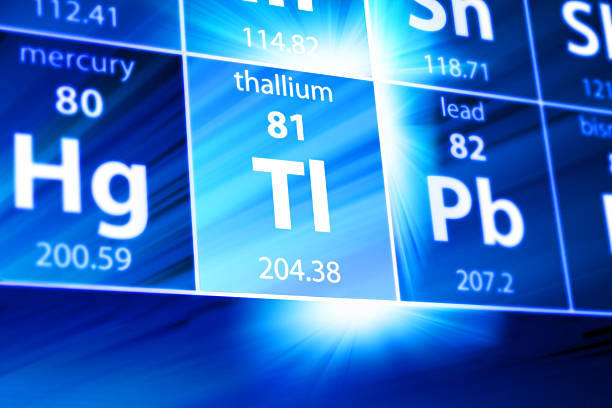Thallium

Thallium ingested at levels above the USEPA’s MCL over an extended period, can result in serious health effects. Safe Home offers a couple kits that provide drinking water testing for thallium in city and well water supplies.
Parameter Type: Drinking Water Testing for Metals
Parameter Name: Thallium
What it is and Where it Comes From:
Thallium is in the Periodic Table with an atomic number of 81 and symbol Tl. It is bluish gray in color. In its natural state, thallium is odorless and tasteless. Sometimes it is found as a compound with bromine, chlorine, fluorine, and iodine. Thallium is used in rat poison and ant killer. It is also used to treat skin infections and for manufacturing electronic devices. It enters the environment from cement factories, coal burning power plants, and metal sewers. The leaching of thallium from ore processing operations is the major source of elevated thallium concentrations in water. It is known to stay in the air, water, and soil for a long period of time after it is released. Thallium (TI) is a rare heavy metal in drinking water, but its extreme toxicity makes its removal crucial to consumer health. Drinking water testing gives you several benefits like peace of mind, identifying contaminants in your water, and insight into health concerns. Safe Home offers Laboratory drinking water testing kits for thallium, allowing you to collect your water sample and ship it directly to our EPA-Certified Laboratory. This platform of drinking water testing for thallium will give you an accurate level based on the lowest level of a parameter our instruments can detect (Method Detection Level). Safe Home drinking water testing for metals can be used for city and well water supplies. Drinking water testing should be done any time you notice a significant change in your water quality.
Health Effects:
Short-term effects the EPA has found thallium to potentially cause the following health effects when people are exposed to it at levels above the MCL for relatively short periods of time is gastrointestinal irritation and nerve damage. Long-term effects thallium has the potential to cause the following effects from a lifetime exposure at levels above the MCL are changes in blood chemistry, damage to liver, kidney, intestinal, testicular issues, vomiting, diarrhea, and hair loss. Birth defects have been reported from exposure to Thallium and effects on the lungs, heart, kidney, and liver. Drinking water testing is a great way to monitor thallium levels in your city or well water supplies.
Solutions to Contaminant Levels:
If thallium is present above this level, the system must continue to monitor this contaminant every 3 months. The following treatment methods have been approved by EPA for removing thallium activated alumina and ion exchange. Both activated alumina and ion exchange can result in 90 and 95 percent removal efficiency of thallium. Activated alumina (AA) uses a porous, granular, aluminum media to adsorb ions from solution. Activated alumina media can either be regenerated through a series of washes or replaced when it becomes saturated. Ion exchange is a water treatment method where one or more undesirable ionic contaminants are removed from water by exchange with another non-objectionable, or less objectionable ionic substance. Both the contaminant and the exchanged substance must be dissolved and have the same type of electrical charge (positive or negative). A typical example of ion exchange is a process called “water softening” aiming to reduce calcium and magnesium content. Nevertheless, ion exchange is efficient in removing toxic metals from water. Who do I need to contact to find out more information about water quality in my area? Every community water supplier must provide an annual report to its customers, known as a Consumer Confidence Report (CCR). The report provides information on your local drinking water quality, including the water’s source, contaminants found in the water, and how consumers can get involved in protecting drinking water. How often does the local public water system preform drinking water testing? Frequency of drinking water testing depends on the number of people served, the type of water source, and types of contaminants. Certain contaminants are tested more frequently than others, as established by the Safe Drinking Water Act. You can find out about levels of regulated contaminants in your treated water for the previous calendar year in your annual Consumer Confidence Report (CCR).


